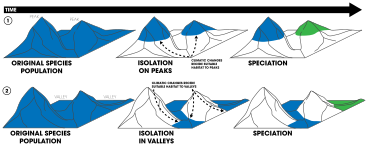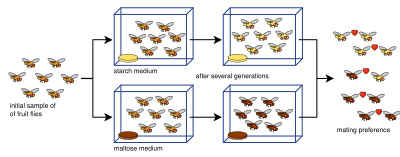Allopatric speciation
Nevertheless, verbal and mathematical models, laboratory experiments, and empirical evidence overwhelmingly supports the occurrence of allopatric speciation in nature.represents the entire continuum,[9] although some scientists argue[2][10] that a classification scheme based solely on geographic mode does not necessarily reflect the complexity of speciation.For example, if a plant experiences a chromosome duplication event, reproduction will occur, but sterile hybrids will result—functioning as a form of post-zygotic isolation.However, reinforcement may also play a role in allopatric speciation, whereby the reproductive barrier is removed, reuniting the two previously isolated populations.[14] A major difficulty arises when interpreting reinforcement's role in allopatric speciation, as current phylogenetic patterns may suggest past gene flow.[1]: 105 However, it can often be difficult for researchers to determine if peripatric speciation occurred as vicariant explanations can be invoked due to the fact that both models posit the absence of gene flow between the populations.[30] Gustave Paulay found evidence that species in the subfamily Cryptorhynchinae have microallopatrically speciated on Rapa and its surrounding islets.[31] A sympatrically distributed triplet of diving beetle (Paroster) species living in aquifers of Australia's Yilgarn region have likely speciated microallopatrically within a 3.5 km2 area.[13] First, divergent selection separates a non-allopatric population emerging from pre-zygotic barriers, from which genetic differences evolve due to the obstruction of complete gene flow.[40] This isolation on "mountain top islands" creates barriers to gene flow, encouraging allopatric speciation, and generating the formation of endemic species.[53][54] The formation of the Himalayan mountains and the Qinghai–Tibetan Plateau for example have driven the speciation and diversification of numerous plants and animals[55] such as Lepisorus ferns;[56] glyptosternoid fishes (Sisoridae);[57] and the Rana chensinensis species complex.[61] Adaptive radiation, like the Galapagos finches observed by Charles Darwin, is often a consequence of rapid allopatric speciation among populations.[63] Recent evidence increasingly points towards an older and more complex emergence of the Isthmus, with fossil and extant species dispersal (part of the American biotic interchange) occurring in three major pulses, to and from North and South America.[65][66] Regardless of the exact timing of the isthmus closer, biologists can study the species on the Pacific and Caribbean sides in what has been called, "one of the greatest natural experiments in evolution".[62] Additionally, as with most geologic events, the closure was unlikely to have occurred rapidly, but instead dynamically—a gradual shallowing of sea water over millions of years.[1]: 93 Studies of snapping shrimp in the genus Alpheus have provided direct evidence of an allopatric speciation event,[67] as phylogenetic reconstructions support the relationships of 15 pairs of sister species of Alpheus, each pair divided across the isthmus[62] and molecular clock dating supports their separation between 3 and 15 million years ago.[1]: 97 Glaciation and subsequent retreat caused speciation in many boreal forest birds,[70] such as with North American sapsuckers (Yellow-bellied, Red-naped, and Red-breasted); the warblers in the genus Setophaga (S. townsendii, S. occidentalis, and S. virens), Oreothlypis (O. virginiae, O. ridgwayi, and O. ruficapilla), and Oporornis (O. tolmiei and O. philadelphia now classified in the genus Geothlypis); Fox sparrows (sub species P.schistacea); Vireo (V. plumbeus, V. cassinii, and V. solitarius); tyrant flycatchers (E. occidentalis and E. difficilis); chickadees (P. rufescens and P. hudsonicus); and thrushes (C. bicknelli and C.[70] As a special case of allopatric speciation, peripatric speciation is often invoked for instances of isolation in glaciation refugia as small populations become isolated due to habitat fragmentation such as with North American red (Picea rubens) and black (Picea mariana) spruce[71] or the prairie dogs Cynomys mexicanus and C.[15][1]: 90 Reproductive isolation has been shown to arise from pleiotropy (i.e. indirect selection acting on genes that code for more than one trait)—what has been referred to as genetic hitchhiking.[15] Limitations and controversies exist relating to whether laboratory experiments can accurately reflect the long-scale process of allopatric speciation that occurs in nature.number desiccation resistance, fecundity, ethanol resistance; courtship display, re-mating speed, lek behavior; pupation height, clumped egg laying, general activity D. persimilis Early speciation research typically reflected geographic distributions and were thus termed geographic, semi-geographic, and non-geographic.[136] His idea was later interpreted by Ernst Mayr as a form of founder effect speciation as it focused primarily on small geographically isolated populations.[137] Controversy exists as to whether Charles Darwin recognized a true geographical-based model of speciation in his publication of the Origin of Species.[136] David Starr Jordan played a significant role in promoting allopatric speciation in the early 20th century, providing a wealth of evidence from nature to support the theory.Like Jordan's works, they relied on direct observations of nature, documenting the occurrence of allopatric speciation, of which is widely accepted today.[1]: 2 Other scientists noted the existence of allopatrically distributed pairs of species in nature such as Joel Asaph Allen (who coined the term "Jordan's Law", whereby closely related, geographically isolated species are often found divided by a physical barrier[1]: 91 ) and Robert Greenleaf Leavitt;[141] however, it is thought that Wagner, Karl Jordan, and David Starr Jordan played a large role in the formation of allopatric speciation as an evolutionary concept;[142] where Mayr and Dobzhansky contributed to the formation of the modern evolutionary synthesis.[37] Molecular clock dating methods are also often employed to accurately gauge divergence times that reflect the fossil or geological record[1]: 93 (such as with the snapping shrimp separated by the closure of the Isthmus of Panama[68] or speciation events within the genus Cyclamen[145]).Other techniques used today have employed measures of gene flow between populations,[13] ecological niche modelling (such as in the case of the Myrtle and Audubon's warblers[146] or the environmentally-mediated speciation taking place among dendrobatid frogs in Ecuador[144]), and statistical testing of monophyletic groups.[147] Biotechnological advances have allowed for large scale, multi-locus genome comparisons (such as with the possible allopatric speciation event that occurred between ancestral humans and chimpanzees[148]), linking species' evolutionary history with ecology and clarifying phylogenetic patterns.








allochronic speciationEvolutionary biologyDarwin's finchesJohn GouldIntroductionOutlineGlossaryEvidenceHistoryPopulation geneticsVariationDiversityMutationNatural selectionAdaptationPolymorphismGenetic driftGene flowSpeciationAdaptive radiationCo-operationCoevolutionCoextinctionContingencyDivergenceConvergenceParallel evolutionExtinctionOrigin of lifeCommon descentHistory of lifeTimeline of evolutionHuman evolutionRecent human evolutionPhylogenyBiodiversityBiogeographyClassificationEvolutionary taxonomyCladisticsTransitional fossilExtinction eventOverviewRenaissanceBefore DarwinDarwinOrigin of SpeciesBefore synthesisModern synthesisMolecular evolutionEvo-devoCurrent researchHistory of speciationHistory of paleontologytimelineApplications of evolutionBiosocial criminologyEcological geneticsEvolutionary aestheticsEvolutionary anthropologyEvolutionary computationEvolutionary ecologyEvolutionary economicsEvolutionary epistemologyEvolutionary ethicsEvolutionary game theoryEvolutionary linguisticsEvolutionary medicineEvolutionary neuroscienceEvolutionary physiologyEvolutionary psychologyExperimental evolutionInvasion geneticsIsland biogeographyPhylogeneticsPaleontologySelective breedingSpeciation experimentsSociobiologySystematicsUniversal DarwinismEugenicsEvolution as fact and theoryDysgenicsSocial effectsCreation–evolution controversyTheistic evolutionObjections to evolutionLevel of supportNature-nurture controversyAncient Greekmovement of continentsgeneticselective pressuresmutationsgene poolsreproductive isolationpopulation dispersalperipatric speciationorganismsrangessympatrydefining speciesDrosophilaLéon Croizatdisjunct distributionsgeologictopographicorogenyglaciationland bridgestectonic platessky islandshabitat fragmentationgenotypicphenotypicecological nichephylogenetic niche conservatismparapatric speciationdivergent selectionhybridchromosome duplication eventsterileReinforcement (speciation)sympatric speciationsecondary contact